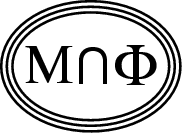
Back to
OP page
Combined
List
List by
Contributors
 Back to OP page Combined List List by Contributors |
IMPOSSIBILITY THEOREMS IN MATHEMATICAL PHYSICSContributed by: Andrew Lenard (Indiana Univ.), Nov. 10, 1998.Abstract It is proposed that certain common expressions such as "no exact formula exists" or "no explicit solution is expected" are to be made precise so that these assertions become mathematically provable or perhaps disprovable. Two concrete instances are suggested, one in statistical mechanics, the other in quantum mechanics.Comment by Alan Sokal |
Some of the greatest contributions to mathematics, but particularly in
the 19th and 20th centuries, were impossibility theorems. Already the Ancients
contributed some: For instance, the irrationality of the square root of
2 can be interpreted this way. From the 19th century we remember Abel's
proof of the impossibility of solving the quintic equation by roots alone;
Lindenman's proof of the transcendental nature of Pi; Beltrami's presentation
of a model for hyperbolic geometry, thus proving the impossibility of "proving"
Euclid's Fifth Postulate; and a less known essay of Bruns showing that
in the Newtonian 3-body problem there are no constants of motion, algebraic
but algebraically independent of the ten classical ones. In the 20th century,
perhaps a peak of all mathematics was Godel's theorem to the effect that
no consistent and "provable" axiomatization of sufficiently complex theories
are possible. In this category falls also Hilbert's 10th problem, to whose
solution Julia Robinson made an important contribution.
I propose to raise the challenge of coming up with and solving some such
problems in the area of mathematical physics. Most of us, practitioners
of this subtle art, know of sayings such as "This or that problem has no
explicit solution" or "exact solution." Such things should not just be
asserted; they should be proved. Of course -- as the above cited history
of mathematics shows -- one must first formulate an exact definition of
what it means (in any given context) an "exact solution" or any other
characterization
whose impossibility is asserted. Even just the very setting up of such
a definition would be a worthwhile task.
Let me mention two specific problems of this type that come to my
mind.
1. A great event in statistical mechanics was Onsager's famous formula
for the 2-dimensional Ising Model. Most people agree that no such "formula"
exists for the 3-dimensional case.
What does "formula" mean in this context?
And is the nonexistence for the 3-dimensional case a theorem?
2. In quantum mechanics surely most of us heard it asserted that
the Helium atom's energy levels cannot be determined "exactly" as those
of the Hydrogen atom can.
Again, what does "exactly" mean here? Could this be proved?